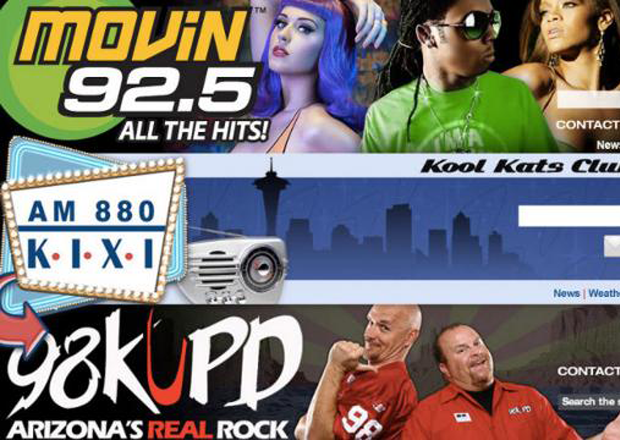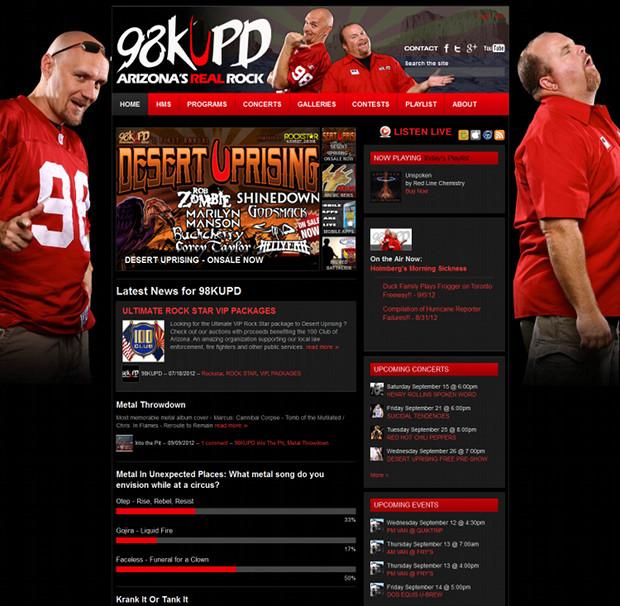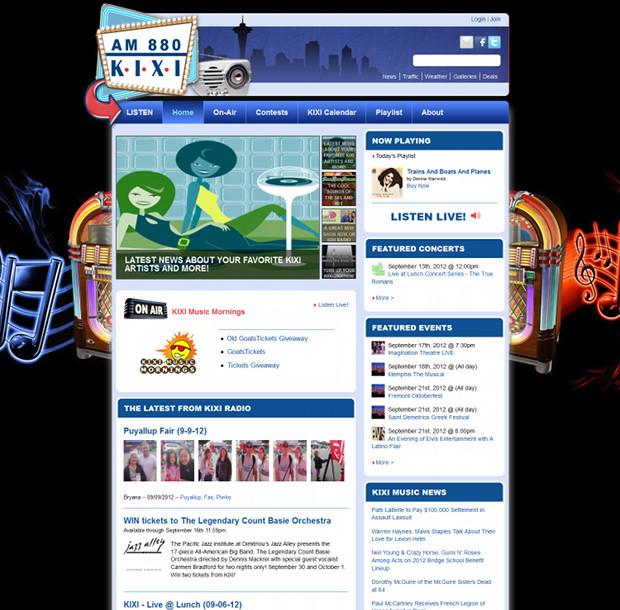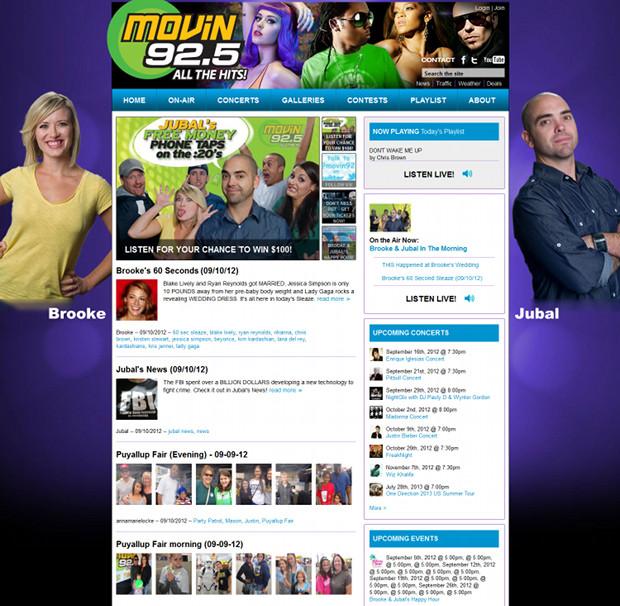 Support for Drupal 7 is ending on 5 January 2025—it’s time to migrate to Drupal 10! Learn about the many benefits of Drupal 10 and find migration tools in our resource center.
Support for Drupal 7 is ending on 5 January 2025—it’s time to migrate to Drupal 10! Learn about the many benefits of Drupal 10 and find migration tools in our resource center.Sandusky Digital, with radio stations in the Phoenix and Seattle markets, needed to replace an aging CMS infrastructure with one that gives website administrators the ability to efficiently create engaging content that caters to each station’s unique radio personalities and audience, thereby maximizing engagement and sales opportunities in their respective markets.
“Our system was antiquated and limited our opportunities, causing frustration and wasted staff time trying to manage downtime and archaic admin tools,” Patrick O’Brien, Project Manager of Sandusky said. “We’d outgrown what was offered...and the vendor had not kept up with a changing new media landscape.”
To bring their radio stations into the new era, Sandusky partnered with Bluespark to create 11 radio station websites driven by a common codebase yet allowing for each station site to be deployed with its own unique brand, audience, and features in just six months.

Drupal was chosen because it offered us the opportunity to create a common codebase yet allowing for each station site to be deployed with its own unique brand, audience, and features in just six months.
The business goals of the project centered around creating a common platform for the deployment and management of many similar yet distinct websites. Along with dozens of minor requests, major requirements included a shared core CMS, open architecture, separate and distinct branding for each site, individual content across each site, different user role parameters, advertising management system, listener clubs, and synchronization with current on-air programming.
The three primary disciplines (UX, Creative, and Development) of Bluespark’s holistic approach worked together to create a common Drupal 7 solution that achieved Sandusky's goals. Further, the solution delivered value realized in a lower cost-per-site, when compared to typical project budget expenditures for a single site in the portfolio of radio stations.
User Experience Solution
Bluespark needed to find functionalities that were common to all but could be deployed independently and could be used to drive value across all of the sites. The UX team conducted a stakeholder discovery process, interviewing radio representatives from each station to learn the property’s unique brand and to determine features that would provide disc jockeys ways to engage their audiences.
After learning of each station’s individual needs, the UX team had a roster of available functions and tools that individually met a critical need, but as a collective represented a set of building blocks that each station used to assemble a ‘custom’ and unique site.
This choice puts the power of flexibility and creativity into each station’s hands, and with a solid understanding of how each tool addresses users, a station can deploy a site that works for their unique audience.
Creative Solution
To take eleven different ideas about how a radio station should look and turn it into a design framework, Bluespark’s creative team designed mood boards that captured the essence of each station’s brand. Each board defined the fonts, color palette, and imagery and established a cohesive art direction for each site. Having a clear individual art direction, a user interface (UI) was created based upon a universal wireframe and then further personalized for each site, carrying over established ideas from the mood boards. Customized elements like headers and background images further established individuality and helped convey the format of each station.
Bluespark’s Creative team took a novel three-tier approach to themeing, using Omega as a base. An intermediate level theme with styles and layout code that would apply to all 11 sites was implemented on top of Omega, and then on a per-site level we extend the cross-site styles with a sub-theme unique to each station. The Panelizer module allowed site webmasters to further customize each site reorganizing the layout of certain brand-intensive pages such as the homepage and radio show pages.
The end result? A common design and theme framework, but in appearance, 11 different radio station websites.
Development Solution
To accommodate the differences between the sites yet have them share a majority of their functionalities, Bluespark’s Technical team had to put together an advanced and innovative Drupal system that spanned a wide range of Drupal technologies and best practices.
The site was built as a Drupal Multisite installation, with all 11 sites using a single codebase making development much more efficient. Each building block identified by the UX team was packaged as a Drupal Feature, making it easy for site administrators to activate and developers to deploy using Drush.
The Omega theme was used as the standard base theme across the sites providing a modern and flexible foundation to build upon.
Noteworthy Features
In addition to taking advantage of a well supported Drupal modules such as CTools, Panels and Views, the Bluespark team introduced novel customizations that were specific to the customers requirements and not readily available via existing modules.
- Photo Galleries take what Drupal readily provides and enhances it extensively with custom extensions that allow for an easy way to bulk upload images, add SEO-friendly metadata, and drag-and-drop rearrangement of images and intermingled adverts selected from the site-wide Ad Management System. The end result is a flexible and powerful Gallery tool that takes the best of what Drupal makes available and enhances it to make it easy on content managers and the ad sales team alike.
- The forms used throughout the site were enhanced to provide seamless automated integration with MailChimp allowing the client to collect relevant user data and to create rewards programs.
- The center of what a radio station site does is the ability to display what’s On Air now and what is next on the playlist. Bluespark tightly integrated each Drupal site with the radio station’s existing playlist system to pull that information in as well as allow content managers to set up show schedules.
Station Sites
Technical specifications
We used Drupal 7 for the build, and our complete suite of modules chosen allowed us to build with flexibility and long-term sustainability in mind.
- The Panelizer module's initial port to Drupal 7 was completed for this project and has become an important part of the Panels infrastructure for Drupal 7.
- The Menu MiniPanels module's initial port to Drupal 7 was completed and provides the "mega menus" seen on all sites and has become quite popular.
- The References Manager module was built as a more user-friendly system for managing node references. Other potential uses include sorting Commerce products.
From the Sandusky project team, Patrick O'Brien, Drew Hutchinson, and Brian Westbrook.



Comments
Drupal Radio Group / Station Module
Nice job!
I am interested, as I am sure the folks that subscribe to the drupal radio group would be too, to hear more about the integration that you did for each station with the automation systems. Maybe you would consider contributing some code to the station module.
I started a new discussion on the Drupal Radio Group page about this Drupal Case Study. You could comment on it if wanted to share more with the group.
_
I just visited kixi.com and however the theme is so simple (as you said, you used omega theme), but the colors are chosen wisely and combination of them, makes this site fantastic. I liked it. Also font color and font size of titles and also contents are nice and attracts visitors to read them. I also have a question. Why the structure of page links are like this? i.e kixi.com/homepage/page/4/0 .Is there any special reason for this style of links?